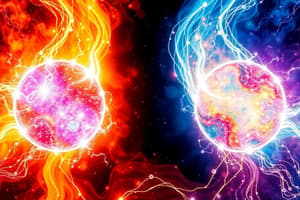Podcast
Questions and Answers
What is the definition of oxidation?
What is the definition of oxidation?
The addition of oxygen/electronegative element to a substance or the removal of hydrogen/electropositive element from a substance.
What does "redox" stand for?
What does "redox" stand for?
Reduction-oxidation
What is an oxidizing agent?
What is an oxidizing agent?
A reagent that increases the oxidation number of an element in a given substance.
What is a reducing agent?
What is a reducing agent?
What does oxidation number denote?
What does oxidation number denote?
What is the oxidation number in the elemental state?
What is the oxidation number in the elemental state?
What is the oxidation number of oxygen in most compounds?
What is the oxidation number of oxygen in most compounds?
What is the oxidation number of a monatomic ion?
What is the oxidation number of a monatomic ion?
Where does the oxidation number of hydrogen deviate from +1?
Where does the oxidation number of hydrogen deviate from +1?
What is the oxidation number of fluorine in all its compounds?
What is the oxidation number of fluorine in all its compounds?
What is the algebraic sum of oxidation numbers of all atoms in a compound?
What is the algebraic sum of oxidation numbers of all atoms in a compound?
All decomposition reactions are redox reactions.
All decomposition reactions are redox reactions.
The reaction between zinc and copper nitrate is a displacement reaction.
The reaction between zinc and copper nitrate is a displacement reaction.
What type of reaction is the combination of carbon with oxygen to form carbon dioxide?
What type of reaction is the combination of carbon with oxygen to form carbon dioxide?
What type of reaction is the breakdown of hydrogen peroxide into water and oxygen?
What type of reaction is the breakdown of hydrogen peroxide into water and oxygen?
What type of reaction is the displacement of hydrogen from hydrochloric acid by zinc?
What type of reaction is the displacement of hydrogen from hydrochloric acid by zinc?
What type of reaction is the simultaneous reduction and oxidation of the same element?
What type of reaction is the simultaneous reduction and oxidation of the same element?
The reaction of potassium dichromate with sodium sulphite in an acid solution is an example of a redox reaction?
The reaction of potassium dichromate with sodium sulphite in an acid solution is an example of a redox reaction?
Which of the following statements is NOT true about redox reactions?
Which of the following statements is NOT true about redox reactions?
Which of the following is NOT an example of a redox reaction?
Which of the following is NOT an example of a redox reaction?
Which of the following statements is true about the concept of oxidation number?
Which of the following statements is true about the concept of oxidation number?
Which of the following metals is the most active reducing agent?
Which of the following metals is the most active reducing agent?
Which of the following halogens is the strongest oxidizing agent?
Which of the following halogens is the strongest oxidizing agent?
Which of the following reactions is NOT a disproportionation reaction?
Which of the following reactions is NOT a disproportionation reaction?
Which of the following is true about the use of indicators in redox titrations?
Which of the following is true about the use of indicators in redox titrations?
Which of the following statements is NOT true about the standard electrode potential (E) of an electrode?
Which of the following statements is NOT true about the standard electrode potential (E) of an electrode?
Which of the following is a correct statement about the use of the half-reaction method to balance redox reactions?
Which of the following is a correct statement about the use of the half-reaction method to balance redox reactions?
In a galvanic cell, electrons travel from the anode to the cathode through the external circuit.
In a galvanic cell, electrons travel from the anode to the cathode through the external circuit.
The electrode potential of an electrode is independent of the concentration of the species involved in the electrode reaction.
The electrode potential of an electrode is independent of the concentration of the species involved in the electrode reaction.
A redox couple consists of an oxidised form and a reduced form of the same species.
A redox couple consists of an oxidised form and a reduced form of the same species.
A salt bridge is used in a galvanic cell to provide a pathway for the flow of electrons between the electrodes.
A salt bridge is used in a galvanic cell to provide a pathway for the flow of electrons between the electrodes.
Flashcards
Redox Reaction
Redox Reaction
A chemical process involving the transfer of electrons between reactants, resulting in a change in oxidation states.
Reduction
Reduction
The gain of electrons by a chemical species, resulting in a decrease in its oxidation state.
Oxidation
Oxidation
The loss of electrons by a chemical species, resulting in an increase in its oxidation state.
Oxidizing Agent
Oxidizing Agent
Signup and view all the flashcards
Reducing Agent
Reducing Agent
Signup and view all the flashcards
Oxidation Number
Oxidation Number
Signup and view all the flashcards
Combination Redox Reaction
Combination Redox Reaction
Signup and view all the flashcards
Decomposition Redox Reaction
Decomposition Redox Reaction
Signup and view all the flashcards
Displacement Redox Reaction
Displacement Redox Reaction
Signup and view all the flashcards
Disproportionation Redox Reaction
Disproportionation Redox Reaction
Signup and view all the flashcards
Acid-Base Reaction
Acid-Base Reaction
Signup and view all the flashcards
Acid
Acid
Signup and view all the flashcards
Base
Base
Signup and view all the flashcards
Redox Reaction
Redox Reaction
Signup and view all the flashcards
Reduction
Reduction
Signup and view all the flashcards
Oxidation
Oxidation
Signup and view all the flashcards
Oxidizing Agent
Oxidizing Agent
Signup and view all the flashcards
Reducing Agent
Reducing Agent
Signup and view all the flashcards
Oxidation Number
Oxidation Number
Signup and view all the flashcards
Combination Redox Reaction
Combination Redox Reaction
Signup and view all the flashcards
Decomposition Redox Reaction
Decomposition Redox Reaction
Signup and view all the flashcards
Displacement Redox Reaction
Displacement Redox Reaction
Signup and view all the flashcards
Disproportionation Redox Reaction
Disproportionation Redox Reaction
Signup and view all the flashcards
Acid-Base Reaction
Acid-Base Reaction
Signup and view all the flashcards
Acid
Acid
Signup and view all the flashcards
Base
Base
Signup and view all the flashcards
Oxidation Number Method
Oxidation Number Method
Signup and view all the flashcards
Half Reaction Method
Half Reaction Method
Signup and view all the flashcards
Study Notes
Redox Reactions
- Redox reactions involve simultaneous oxidation and reduction
- Oxidation is defined as the addition of oxygen or the removal of hydrogen, and gain of electrons
- Reduction is defined as the removal of oxygen or the addition of hydrogen, and loss of electrons
- Oxidant (oxidising agent) causes oxidation
- Reductant (reducing agent) causes reduction
Classical Idea of Redox Reactions
- Oxidation was originally defined as the addition of oxygen to a substance.
- Reduction was originally defined as the removal of oxygen to a substance.
- Oxidation and Reduction are always coupled processes.
Redox Reactions in Terms of Electron Transfer Reactions
- Oxidation is defined as the loss of electrons, and reduction is defined as the gain of electrons.
- A redox reaction involves a transfer of electrons.
Competitive Electron Transfer Reactions
- In a reaction involving zinc and copper nitrate, zinc is oxidised and copper nitrate is reduced.
Oxidation Number
- Oxidation number is a positive or negative integer assigned to an atom in a compound or ion
- Rules for assigning oxidation numbers are used to keep track of electrons in redox reactions.
Types of Redox Reactions
- Combination reactions (e.g., burning of magnesium with oxygen) result in the formation of a new compound.
- Decomposition reactions (e.g., decomposition of hydrogen peroxide) result in the breakdown of a pre-existing compound.
- Displacement reactions (e.g., copper nitrate with zinc) involve the replacement of one element by another.
- Disproportionation reactions (e.g., chlorine reacting with water) an element in an intermediate oxidation state is simultaneously oxidized and reduced
Balancing Redox Reactions
- Methods for balancing redox reactions, such as the oxidation number method and the half-reaction method, involve balancing atoms and charges.
Redox Reactions as the Basis for Titrations
- Redox titrations use redox indicators to determine the endpoint of a reaction.
Studying That Suits You
Use AI to generate personalized quizzes and flashcards to suit your learning preferences.




